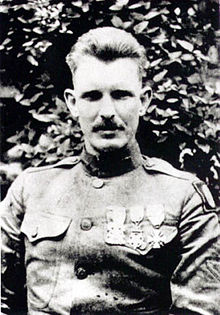Alvin C. York
| Alvin York | |
|---|---|

|
|
| Birth name | Alvin Cullum York |
| Nickname(s) | "Sergeant York" |
| Born |
December 13, 1887 Pall Mall, Tennessee |
| Died | September 2, 1964 (aged 76) Nashville, Tennessee |
| Place of burial | Wolf River Cemetery Pall Mall |
| Allegiance |
|
| Service/branch |
|
| Rank |
Corporal (at time of Medal of Honor action) Sergeant (at end of war) Colonel (Tennessee State Guard WW II rank) |
| Unit | 82d Division |
| Commands held | 7th Regiment, Tennessee State Guard |
| Battles/wars | |
| Awards | |
Alvin Cullum York (December 13, 1887 – September 2, 1964), also known as Sergeant York, was one of the most decorated United States Army soldiers of World War I. He received the Medal of Honor for leading an attack on a German machine gun nest, taking 35 machine guns, killing at least 28 enemy soldiers, and capturing 132. York's Medal of Honor action occurred during the United States-led portion of the Meuse-Argonne Offensive in France, which was intended to breach the Hindenburg line and force the Germans to surrender.
York was born in rural Tennessee; his parents farmed, and his father worked as a blacksmith. The eleven York children had minimal schooling because they helped provide for the family, which included hunting, fishing, and hiring out as laborers. After the death of York's father, he assisted in caring for his younger siblings, and found work as a logger and on construction crews. Despite being a regular churchgoer, York also drank heavily, and was prone to fistfights. After a 1914 conversion experience, he vowed to change, and became even more devoted to the Church of Christ in Christian Union.
York was drafted during World War I; he initially claimed conscientious objector status on the grounds that his denomination forbade violence. Persuaded that his religion was not incompatible with military service, York joined the 82nd Division as an infantry private, and went to France in 1918. In October 1918, as a newly-promoted corporal, York was one of a group of 17 soldiers assigned to infiltrate German lines and silence a machine gun position. After the American patrol had captured a large group of enemy soldiers, their small arms fire killed six Americans and wounded three. York was the highest ranking of those still able to fight, so he took charge. While his men guarded the prisoners, York attacked the machine gun position, dispatching several soldiers with his rifle. By the time six Germans charged him with bayonets he was out of rifle ammunition, so he drew his pistol and shot them all. The German officer responsible for the machine gun position had emptied his pistol while firing at York, but failed to hit him. This officer then offered to surrender, and York accepted. York and his men marched back to their unit's command post with more than 130 prisoners. York was immediately promoted to sergeant, and was awarded the Distinguished Service Cross; a later investigation led to this award being upgraded to the Medal of Honor. York became a national hero and international celebrity; he went on to receive decorations from several foreign countries, including France, Italy, and Montenegro.
...
Wikipedia

